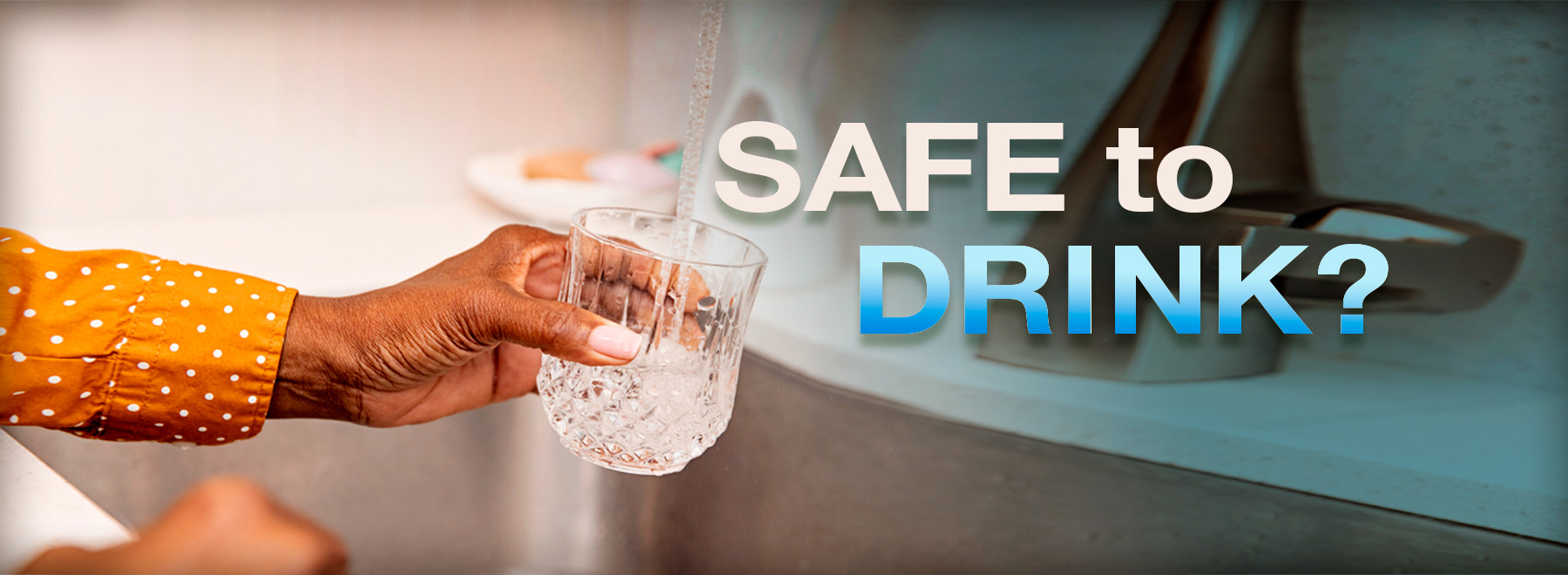Left unchecked, water contaminates can devastate your health
After weeks of boil-water alerts and a bonanza for the bottled water business, uncontaminated drinking water is back on tap in the City of Jackson.
Or is it?
In mid-March, following tests for quality by the Mississippi State Department of Health, city officials finally lifted a precautionary boil-water notice for residents after a winter weather emergency in mid-February precipitated water main breaks resulting in low, or no, water pressure for thousands.
But even with repaired mains and restored pressure, questions remain about the water’s drinkability, not only for Jackson, but for water supply systems elsewhere in the state and the country.
Those questions are attached to fears about aging water infrastructure, lead-contaminated water from ancient pipes, potential exposure to a host of unregulated contaminants, and more.

“Generally, our water in the U.S. is safe to drink, especially when you think about what it looked like in the 1920s and ’30s,” said Stephanie Otts, a co-leader of the interdisciplinary research team of the Lead in Water Project at the University of Mississippi in Oxford, where she is also director of the National Sea Grant Law Center.
“We’re not worried about cholera or other pathogens anymore,” said Otts, whose team has probed the risk of possible lead contamination in drinking water. “But what we don’t know as much about are the contaminants affecting certain segments of the population: That might be of more concern.”
Those impurities include lead, the heavy metal once used in paint, plumbing materials and gasoline. This is especially concerning for small children, Otts said.
“The problem is lead from pipes coming into your home, or it can also be from fixtures and faucets on your sink, or from hot water heaters. All this is more likely to be the case with older homes.”
Although the federal government banned lead-based house paint in 1978, the prohibition for lead in plumbing did not appear until 1986. Many homes built before then were equipped with lead pipes.
Otts and her colleagues began taking on lead not long after word of the Flint, Michigan water crisis started leaking out.
“Around that time, the City of Jackson announced that its water supply had exceeded the action level for lead,” Otts said. “That’s really what brought the team together.
“All the attention was on Flint, but we wanted to learn more about how many Mississippi communities might also be dealing with this challenge.”
Their focus has been on the “resource-challenged” rural water associations in the Mississippi Delta and the City of Jackson, Otts said.
“These are places that don’t have the funding to do big upgrades to the systems.”
What’s at stake for the water systems’ customers is, of course, their health.
Although an adult’s contact with lead – usually an occupational hazard – can cause damage to the cardiovascular, reproductive and other systems, the effect on children can be even more far-reaching.
“The primary issue is the neurological impact,” Otts said. “It can mean decreases in I.Q. It has also been linked to attention deficit disorder and hyperactivity. Learning impacts for children are risks, even at lower-level exposures.”

The consequences are permanent. That’s because, with children, the central nervous system is still developing, said Dr. Kristie Willett, professor of pharmacology and environmental toxicology and chair of biomolecular sciences in the School of Pharmacy at the University of Mississippi.
“And lead is a neurotoxin,” said Willett, another co-leader of the UM Lead in Water Project. “Lead can also slow growth and development. It can be in the dust children breathe and in old lead-based paint.
“Compared to adults, their gastrointestinal system absorbs more lead.”
Children younger than 6 live in about 3.6 million U.S. households that expose them to the perils of lead-laced paint, reports the Centers for Disease Control and Prevention.
Yes, blood lead levels in children have been going down since the bans, Willett said.
“But the drinking water is still an unappreciated source of lead. It is not everywhere, but lead content could be a very acute problem in certain communities.”
Those include low-income areas, especially in Mississippi.
“No amount of lead is acceptable in our state,” Willett said. “So we need to find it. We know what we need to do: Limit exposure. If we can find it, we can advise people and stop that exposure.”
To that end, the Lead in Water Project brings together households, community organizations and researchers to collect water samples and have them tested.
“We do not currently have funding to collect samples ourselves, but are actively seeking grants and will try to obtain that funding through partnerships with other interested groups,” Otts said.
The project has worked with the Mississippi State Department of Health to get test kits to families of children whose physical exams have uncovered certain blood lead levels, if the families want them.
“We arrange to have samples analyzed and then report the results back to the parents and to MSDH,” Willett said. “Not all the kits come back, though.”
Testing for lead levels in children is also available from the Hinds County Health Department for children ages six months to five years whose water is supplied by the City of Jackson. The $30 cost is covered by Medicaid and other programs.
Residents can also buy a home sampling kit from a certified lab and have water samples analyzed at state-approved labs, including the MSDH Laboratory.
Besides getting test kits to families, the Lead in Water Project shares information about safe drinking water during community events. The team’s recommendations and cautions include:
- Never cook with hot water right out of the tap.
Lead leaching from pipes into the water is more likely to occur this way. - If you know that your pipes were installed before the 1980s, run the taps for one to two minutes first thing in the morning before drinking the water.
Lead leaching, even with old pipes, shouldn’t happen if proper corrosion control measures are in place. But that isn’t always the case, Willett said. - If you can afford it, buy water filters for your sink, but make sure they’re certified to remove lead.
Willett recommends an NSF/ANSI Standard 53 filter. - Don’t make baby formula with unfiltered tap water.
- A rolling boil will kill bacteria in the water, but don’t depend on it to remove lead.
“It could even make the lead content worse by concentrating it,” Otts said. - Get your children tested for blood lead levels when they reach the ages of 12 months and 24 months. This is covered by Medicaid.
Public water systems, too, must test the water.
“They post the results online, in newspapers or with mailed utility bills,” Willett said. “But this is mandated only every three years and the number of samples may not represent accurately the diversity in the water system.
“You should also know that residential water well systems aren’t regulated once they’re drilled. This isn’t unique to Mississippi: It’s nationwide.”
You should also know that there are different definitions for “acceptable” when it comes to tap water. The U.S. Environmental Protection Agency and the Safe Drinking Water Act say the benchmark is no more than 15 parts lead per billion parts water. A comparison is 15 drops of water in an Olympic-size swimming pool.
For her part, Otts said her team has seen two samples that were much higher than that – “one in the high 20 ppb and one more than 80 ppb.”
“The EPA acknowledges, though, that 15 ppb is not a health-based standard,” Otts said. It’s a practical one -- a realistic goal for public drinking water systems to achieve as determined by the agency, she said.
“If you’re worried about the health impacts of lead on small children, that is not a good standard,” she said. “Our team uses five parts per billion instead, because that’s the FDA standard for bottled water.”
But the American Academy of Pediatrics hews to an even stricter target: no more than 1 part per billion for water fountains in schools.
Still, these recommendations and standards don’t take into account a potential problem of undetermined risks: unregulated chemicals. As reported by the Environmental Working Group, there are no legal restrictions for more than 160 unregulated contaminants in U.S. tap water.
“Our team doesn’t track unregulated chemicals,” Otts said, “but from my perspective as an environmental lawyer, chemical contaminants are a huge problem. New ones come on the market all the time.
“The EPA just can’t keep up. And the amount of evidence required to set a standard for action by federal law is complex and bureaucratic, which slows everything down.”
Among the unregulated substances are a group of fluorinated compounds called PFAS, whose health effects on people have varied from study to study. Findings reveal possible links to increased cholesterol levels, a suppressed response to vaccines in children, changes in liver enzymes, increased risk of kidney and testicular cancer, and more.
PFAS are found in some food packaging, Teflon, household products such as polishes and paints, fish and more.
“These are not compounds we want in our drinking water,” Otts said. “But they’re everywhere and the EPA does not required testing for them.
“It’s an open question: How common are those compounds in the water? They are probably more common in areas with manufacturers of such products as firefighting foam, and around some military bases. PFAS in the water have been found at higher levels in such areas.”
Earlier this year, it was reported that the EPA is looking to regulate groups of PFAS. If public water systems are required to treat and adhere to certain standards for PFAS, that could involve “numerous” substances, Otts said.
“So there is the question of where they will find the money to do that. There is a conversation about what water systems already can’t afford.”
The takeaway?
“Our laws about safe drinking water had been focused in the beginning on removing pathogens that caused immediate health risks,” Otts said. “As we learn more about chemical contamination, the questions grow about what is safe.
“Determining those impacts on health means longer-term exposure for people. It’s a harder problem to solve.”
The above article appears in CONSULT, UMMC’s monthly e-newsletter sharing news about cutting-edge clinical and health science education advances and innovative biomedical research at the Medical Center and giving you tips and suggestions on how you and the people you love can live a healthier life. Click here and enter your email address to receive CONSULT free of charge. You may cancel at any time.



